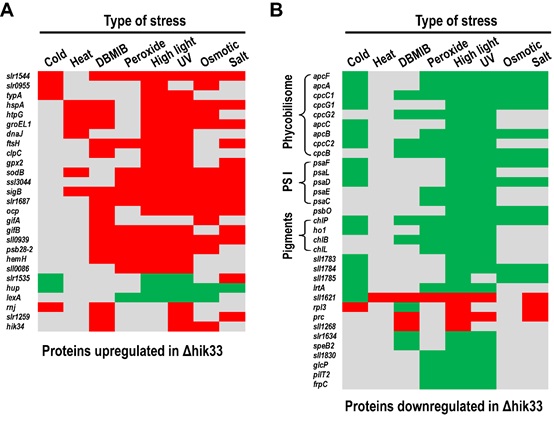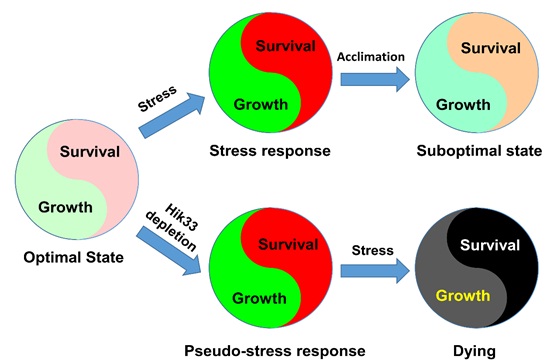Photosynthetic organisms have to coordinate their capacities in photosynthetic biomass production and survival when they are stressed in deleterious environments. However, how such a coordination is achieved remains to be clarified.
Using a photosynthetic model organism Synechocystis sp. PCC 6803, Professors WANG Yingchun’s group from the Institute of Genetics and Developmental Biology, Chinese Academy of Sciences, found that depletion of Hik33, a histidine kinase homologous to ethylene receptor in higher plants, coordinately downregulates proteins in photosynthesis while upregulates heat shock proteins, chaperons, and proteases. Bioinformatic analysis reveals that such a proteome change is a common response to divergent types of stresses (Fig. 1).
This finding establishes Hik33 as a general regulator of stress response in cyanobacteria and underscores the importance of Hik33 in coordinating the photosynthetic biomass production and survival and also explains why Δhik33, a hik33-deficient strain, was more sensitive to different types of stresses (Fig. 2).
Together, their results provide a mechanistic insight, at a system level, on how photosynthetic organism acclimate to divergent type of stresses, and also provide a comprehensive catalog of Hik33-dependent stress responsive proteome. The latter can serve as a useful resource for the scientific community studying how photosynthetic organisms acclimate to changing environments.
This work entitled “
Translating Divergent Environmental Stresses into a Common Proteome Response through Hik33 in a Model Cyanobacterium” has been published online in Molecular & Cellular Proteomics (
DOI:10.1074/mcp.M117.068080) on May 12, 2017.
This work is supported by the National Natural Science Foundation of China (Grant number: 31670234).
 |
|
Fig. 1 The heat maps show the upregulated (A) and the downregulated (B) common stress response (CSR) proteins in Δhik33.(Image by IGDB) |
 |
|
Fig. 2 A diagramed model explaining why Δhik33 is more sensitive to abiotic stresses. (Image by IGDB) |
Contact:
Dr. WANG Yingchun



